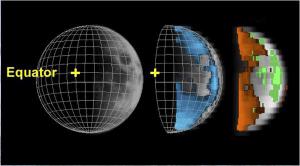Blog
Water from the Sun
11 October 2014
 Science
ScienceThe Moon is a dry, airless rock. At least that is how we imagine it. At basic level, that’s a pretty accurate description. It is drier than any desert on Earth, and its surface would be considered a hard vacuum. But at a more subtle level, that isn’t quite true. The Moon does have the faintest trace of atmosphere, consisting of elements such as argon, helium and hydrogen. The Moon also has traces of water on its surface, mostly locked up within minerals.
That doesn’t mean these minerals are wet by any means. Initial studies of lunar rocks gathered during the Apollo missions found no evidence of water. Only during later, more sophisticated studies was a trace of water discovered. With modern satellites we can detect such traces of water across the lunar surface, such as seen in the image above.
It’s generally been thought that lunar water originated on the Moon in much the same way as it originated on Earth, through water-rich meteorites (chondrites) and comets. But that doesn’t seem to be the case. While some of the Moon’s water clearly did come from impacts, the majority of lunar water is due to a rather surprising source: the Sun.
The discovery was published recently in PNAS, and it looks at isotopes in lunar water.1 Typical water consists of two parts hydrogen to one part oxygen, hence H2O. But there are other variations such as D2O, which is two parts deuterium instead. The ratio of these two varieties of water (known as the D/H ratio) can tell us about the water’s origin. The D/H ratio found in water-rich meteorites is fairly consistent, and it is one of the ways we know meteorites contributed more water to Earth than comets. The D/H ratio found in lunar water doesn’t match that of meteorites. The authors estimate that less than 15% of lunar water could have come from chondrites.
The rest of the water seems to have come from the solar wind. The solar wind consists of protons and electrons that stream away from the Sun. On Earth, these charged particles are caught by our planets magnetic field, causing them to strike the upper atmosphere near the poles, which creates aurora. The Moon lacks a strong magnetic field, so these particles can strike the lunar surface. When protons from the solar wind strike the Moon, they can bond with elements on the surface, such as oxygen. This can lead to the formation of water. Of course, solar-wind produced water also has a distinctive D/H ratio, and the authors were able to show that lunar water was a good match.
So it turns out water can appear on a dry, airless rock. All you need is a bit of solar wind.
Stephant, Alice, and François Robert. “The negligible chondritic contribution in the lunar soils water.” Proceedings of the National Academy of Sciences 111.42 (2014): 15007-15012. ↩︎